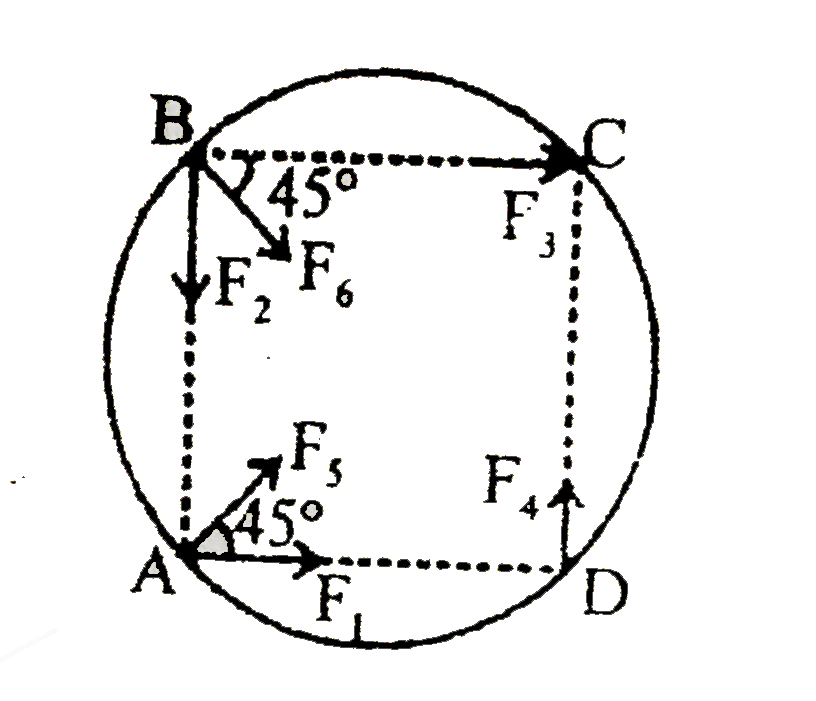A moving particle of mass m is acted upon by five forces→F1,→F2,→–––(F)3,→F4 and →F5. Forces →F2 and →F3 are conservative and their potential energy functions are U and W respectively. Speed of the particle changes from Va to Vb when it moves from position a to b. Which of the following statement is/are true – (a) Sum of work done by →F1,→F4 and →F5=Ub−Ua+Wb−Wa
(b) Sum of work done by →F1,→F4 and →F5=Ub−Ua+Wb−Wa+12m(V2a−V2a)
(c) Sum of work done by all five forces =12m(V2b−V2a)
(d) Sum of work done by →F2 and →F3=(Ub+Wb)−(Ua+Wa)
The correct Answer is:(b),(c)
Step by step video, text & image solution for A moving particle of mass m is acted upon by five forces vec(F)_(1),vec(F)_(2),vec_(F)_(3),vec(F)_(4) and vec(F)_(5. Forces vec(F)_(2) and vec(F)_(3) are conservative and their potential energy functions are U and W respectively. Speed of the particle changes from V_(a) to V_b when it moves from position a to b. Which of the following statement is/are true – (a) Sum of work done by vec(F)_(1),vec(F)_(4) and vec(F)_(5)=U_(b)-U_(a)+W_(b)-W_(a) (b) Sum of work done by vec(F)_(1),vec(F)_(4) and vec(F)_(5)=U_(b)-U_(a)+W_(b)-W_(a)+1/2m(V_(a)^(2)-V_(a)^(2)) (c) Sum of work done by all five forces =1/2m(V_(b)^(2)-V_(a)^(2)) (d) Sum of work done by vec(F)_(2) and vec(F)_(3)=(U_(b)+W_(b))-(U_(a)+W_(a)) by Physics experts to help you in doubts & scoring excellent marks in Class 11 exams.
Updated on:21/07/2023Topper's Solved these Questions
Similar Questions
Three forces (→F1,→F2,→F3) are acting an a particle moving vertically up with constant speed. Two force →F1=−10ˆjN, and →F1=−6ˆi=8ˆj , N are acting an particle on acting on particle respectively find →F3.
View SolutionWhen force −→F1,−→F2,−→F3…...−→Fn act on a particle , the particle remains in equilibrium . If −→F1 is now removed then acceleration of the particle is
View Solution
Knowledge Check
A moving perticle of mass m is acted upon by five forces →F1,→F2,→F3,→F4 and →F5. Forces →F2 and →F3 are conservative and their potential energy funcations are U and W respectively. Speed of the particle changes from Va to Vb when it moves from position a to b. Choose the correct option :
ASum of work done by →F1,→F4 and →F5=Ub−Ua+Wb−WaBSum of work done by →F1,→F4 and →F5=Ub−Ua+Wb−Wa+12m(V2b−V2a)CSum of work done by all five forces =12m(V2b+V2a)DSum of work done by →F2 and →F3=(Ub+Wb)−(Ua+Wa)Two forces −→F1and−→F2 are acting at right angles to each other , find their resultant ?
A√F21−F22B√F21+F22C√(F1+F2)DF1+F2A body placed in free space, is simultaneously acted upon by three forces −→F1,−→F2 and −→F3. The body is in equilibrium and the forces −→F1 and −→F2 are known ot be 36 N due north and 27 N due east respectively. Which of the following best describes the force −→F3?
A36N due southB53N due 60∘ south of eastC45N due 53∘ south of westD45N due 37∘ north of west.
Five forces →F1,→F2,→F3,→F4 , and →F5 , are acting on a particle of mass 2.0kg so that is moving with 4m/s2 in east direction. If →F1 force is removed, then the acceleration becomes 7m/s2 in north, then the acceleration of the block if only →F1 is action will be:
View SolutionThe figure shows a ring in which a square is inscribed. Four equal forces →F1,→F2,→F3,→F4 of magnitude 10N each act at A, B, C, D. Two force F5 and F6 of magnitude 10√2N each act at A and B. The ring will

View SolutionTwo particle A and B, move with constant velocities →v1and→v2. At the initial moment their position vectors are →r1 and →r2 respectively . The condition for particles A and B for their collision is
View SolutionWhen force →F1,→F2,→F3 are acting on a particle of mass m, the particle remains in equilibrium. If the force →F1 is now removed then the acceleration of the particle is :
View SolutionTwo forces are acting on a same body −→F1=(2ˆi+3ˆj−ˆk) and −→F2=(ˆi+2ˆj+4ˆk), then find component of −→F1 along −→F2.
View Solution